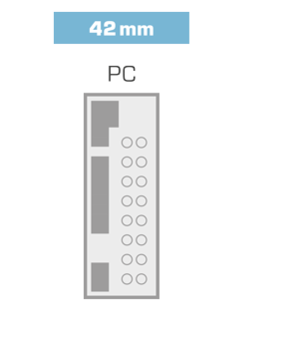When it comes to protecting loads at the 24 V level, conventional circuit breakers are steadily losing ground to electronic circuit breakers. Besides tighter tolerances and a more compact design, these offer further advantages that can really add value within a system if used correctly. When teamed with a higher-level control system, electronic circuit breakers support, via a digital input and output, active switching on or off of any output channel, resetting of tripped circuits and simultaneous reporting of current operating and error statuses. BLOCK multichannel circuit breakers only need up 5.25 mm per channel with all 8-channel modules and can be integrated into the overall control and monitoring process.
OVERVIEW
- Reliable switch-on of high capacities (> 50.000 μF)
- Optimum tripping characteristic for any application
- Adjustable tripping current per channel
- Group alarm signal for simple diagnosis
- Sequential and load-dependent switching-on of channels
- Comprehensive single-channel diagnosis
- Remote reset of tripped channels
ECONOMY SMART - ELECTRONIC CIRCUIT BREAKER WITH THERMOMAGNETIC CHARACTERISTIC
Economy Smart circuit breakers with thermomagnetic characteristic provide an economical alternative to conventional circuit breakers. They also ensure reliable tripping even in the event of a high line resistance. This makes the circuit breakers ideal for use in standard machine production.
BASIC SMART - ELECTRONIC CIRCUIT BREAKER WITH ACTIVE CURRENT LIMITING
The Basic Smart circuit breakers guarantee maximum system availability. In the event of circuit overload, only the faulty current paths are reliably switched off without affecting the remaining circuits due to an active current limiting of 1.7 times the rated current.
The constant current limiting of 1.7 times the rated current enables especially high-capacity loads to be switched on reliably. Two switch-off points within the tripping characteristic allow a temporary increase in current fl ow caused by start-ups, breaking processes, speed and direction changes of DC motors.
SLIM DESIGN FREES UP AMPLE CABINET SPACE
The comparison of 8 protected circuits clearly demonstrates the reduced space requirement – a width of only 5.25 mm per channel for the Power Compact electronic circuit breaker.
SEQUENTIAL SWITCHING
The power on of integrated output channels is time-delayed and load-dependent. As soon as the adjusted trip current of the output channel falls below, the next channel will be switched on. The inrush current of the whole device is levelled off, as the overdimensioning of the power supply is not necessary.















